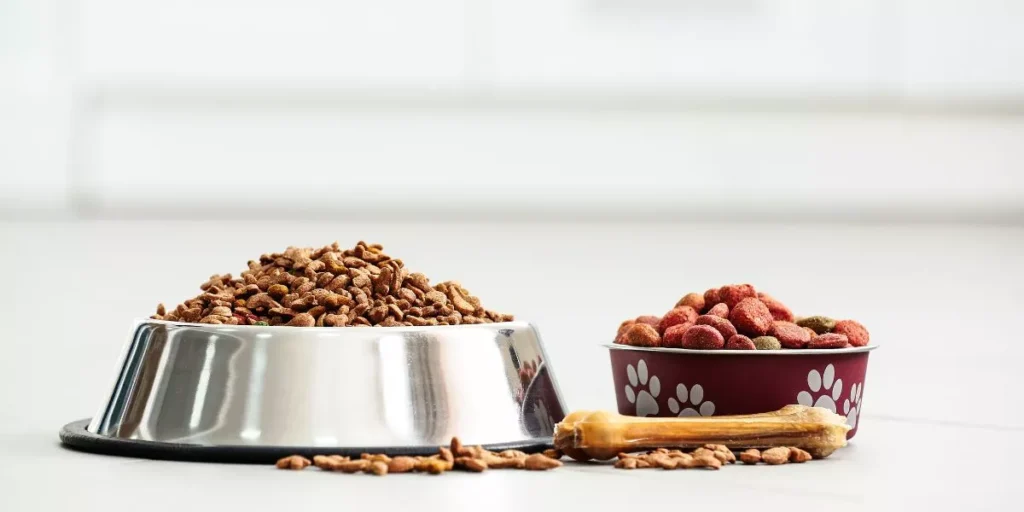
Ensuring proper storage for your dog’s food is more crucial than you might think. Not all containers are created equal, and how you store your pet’s food can significantly impact its quality and safety. From preserving essential nutrients to preventing harmful bacteria growth, high-quality dog food storage plays a pivotal role in your furry friend’s well-being. But what exactly makes a storage solution top-notch? Let’s explore the key factors that can make all the difference in maintaining your dog’s food at its best.
Benefits of Proper Dog Food Storage
Properly storing your dog’s food ensures freshness and nutritional quality are maintained. By keeping the food in an airtight container, you prevent exposure to air and moisture, which can lead to mold growth and spoilage. This means that each time you scoop out a portion for your furry friend, you can be confident they’re getting the best in terms of taste and nutrition.
Additionally, storing your dog’s food properly helps to preserve the essential vitamins and minerals present in the food. When exposed to air, light, and heat, these nutrients can degrade over time, impacting the overall quality of the food. By storing the food in a cool, dark place, you can prolong the shelf life of these vital nutrients, ensuring your dog receives the full benefits of a balanced diet.
Factors Affecting Food Freshness
To maintain the freshness of your dog’s food, understanding the factors that can impact its quality is crucial. Several elements can affect the freshness of your dog’s food, including exposure to air, light, heat, and moisture. Air exposure can lead to oxidation and spoilage, while light exposure can cause nutrient degradation. Heat can accelerate the growth of bacteria and mold, leading to food spoilage. Moisture is another significant factor, as it can create a breeding ground for bacteria and mold, compromising the food’s freshness.
Additionally, the quality of the ingredients used in the dog food plays a vital role in determining its freshness. High-quality ingredients are less likely to spoil quickly compared to low-quality ones. Proper handling and storage practices, such as sealing the bag tightly after each use and storing it in a cool, dry place, can also help preserve the freshness of the food for a longer period. Understanding and addressing these factors are essential in ensuring that your dog receives high-quality and fresh food at every meal.
Importance of Air-Tight Containers
Using air-tight containers is essential for preserving the freshness of your dog’s food. When dog food is exposed to air, it can lead to oxidation, causing the food to become stale more quickly. Air also carries moisture, which can result in mold growth and spoilage of the food. By storing your dog’s food in air-tight containers, you can prevent these issues and ensure that your furry friend receives the best quality nutrition.
Air-tight containers create a barrier that seals out air and moisture, keeping your dog’s food fresh for longer periods. This helps maintain the food’s taste, texture, and nutritional value, ensuring that your dog enjoys every meal. Additionally, air-tight containers help prevent pests such as ants or rodents from contaminating the food.
Investing in high-quality air-tight containers is a simple yet effective way to extend the shelf life of your dog’s food and keep it safe for consumption. Remember, the freshness of your dog’s food plays a crucial role in their overall health and well-being.
Tips for Maintaining Food Quality
Maintaining the quality of your dog’s food involves more than just using air-tight containers; it also requires proper storage practices and regular inspection. To ensure your furry friend receives the best nutrition, store their food in a cool, dry place away from direct sunlight. Keep the food off the ground to prevent moisture buildup and potential contamination. Additionally, try to use the food within a reasonable timeframe to prevent it from going stale or losing its nutritional value.
Inspect the food regularly for any signs of spoilage, such as unusual odors, discoloration, or pest infestations. If you notice any of these issues, promptly dispose of the food and clean the storage container thoroughly before refilling it.
Risks of Improper Storage Practices
Improper storage practices can lead to contamination and degradation of your dog’s food quality. When you leave your dog’s food exposed to air, moisture, or sunlight, you create an environment where bacteria can thrive. This can result in your dog consuming spoiled food, leading to digestive issues or even serious health problems.
Moreover, improper sealing of the food bag can attract pests like insects or rodents, contaminating the food and making it unsafe for your furry friend. In addition, storing your dog’s food in areas with extreme temperatures, such as near a heater or in direct sunlight, can cause the food to lose its nutritional value over time.
Mold growth is another common risk of improper storage, which can produce mycotoxins harmful to your dog’s health. By following proper storage guidelines, such as using airtight containers, storing food in a cool and dry place, and checking for signs of spoilage regularly, you can ensure that your dog enjoys safe and high-quality nutrition.




